Observational Research in the Arctic Ocean to date - Chapter III: Establishing ourselves (2)
January 23, 2023
Takashi KIKUCHI,
Director, Inst. Arctic Climate and Environment Res., Research Inst.
Global Change/Group Leader,
International Observation Planning Group,
Project Office for Arctic Research Vessel (PARV)
This article describes the history of Arctic Ocean observation and research to date, focusing mainly on the activities of Japan and JAMSTEC. Figure 1 shows the interannual variation of minimum sea ice extent in the Arctic Ocean revealed by satellite observation since 1979 with some comments about the purposes and activities of the Arctic Ocean observation. We divide the period from the start of satellite-based sea ice observations in the 1970s to the present into four periods and summarize the objectives and research activities conducted during each period.
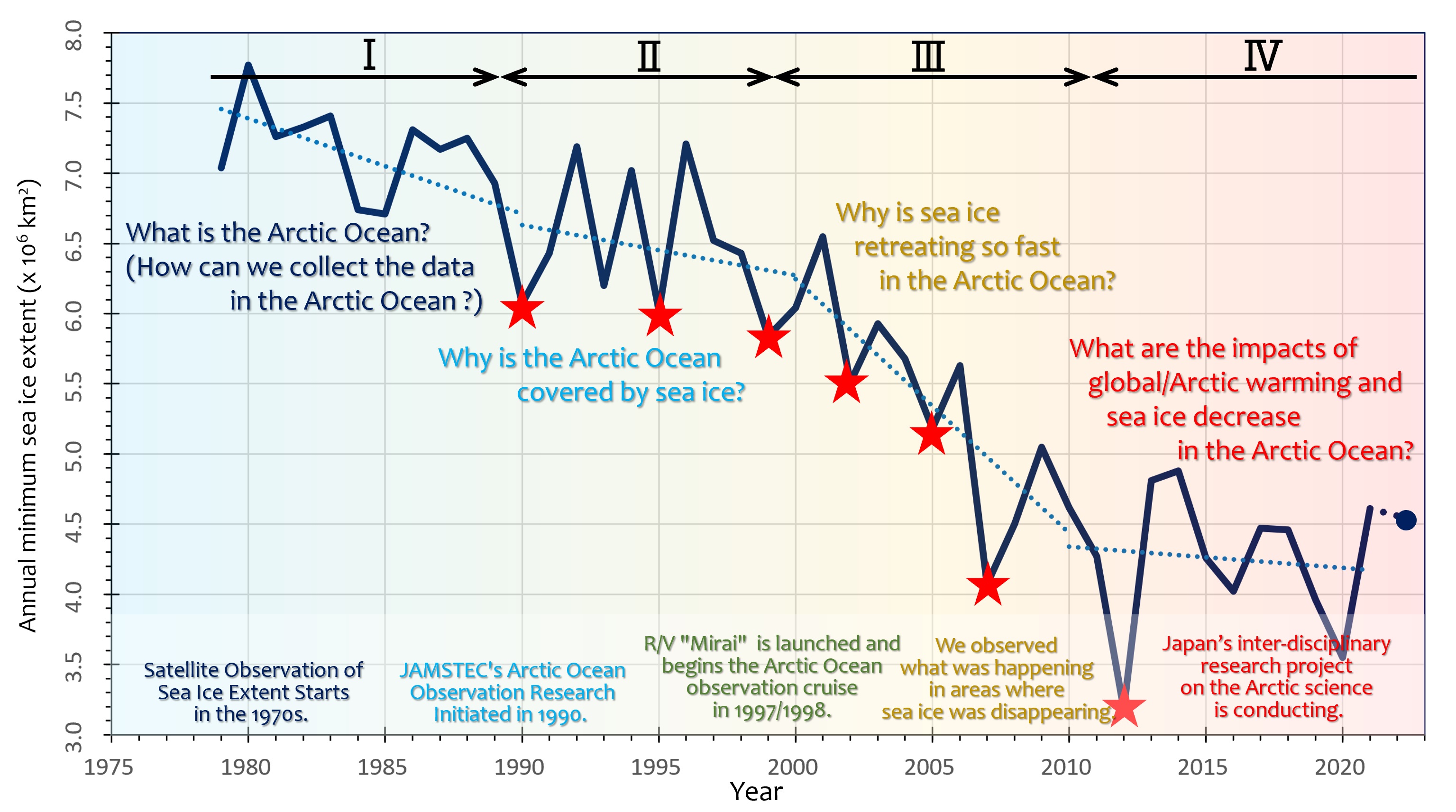
III: Establishing ourselves (2. R/V Mirai Arctic Ocean cruise and the International Research Collaboration)
As shown in the previous chapter (II. Launching), JAMSTEC began observations of the Arctic Ocean in the early 1990s in collaboration with the Woods Hole Oceanographic Institution (WHOI) and the University of Alaska, Fairbanks (UAF), and accumulated observation experience in the Arctic Ocean. Based on these experiences, we initiated scientific observation "research" activities to answer questions such as "Why does sea ice exist in the Arctic Ocean?” (i, ii). In other words, we started to make our own research plans and started observations and development with our own equipment and vessels in the late 1990s. One of the turning points in the development of JAMSTEC's and Japan's Arctic Ocean research was the launch of the oceanographic research vessel "Mirai" (hereafter R/V Mirai).
There is a long story about building R/V Mirai, as you may know. To be short, R/V Mirai was built as a large oceanographic research vessel which was required at that time, by cutting the hull of Japan's first nuclear-powered vessel "Mutsu", removing the nuclear reactor, building a new aft section (the rear of a ship), and joining it to the forward section. If you look closely at R/V Mirai, you will find that there are traces of a cut in the center. Regardless of its origin, it was truly wonderful that a world-class research vessel with excellent navigability, capable of long-term, wide-area oceanographic observations and offshore operations, and high-precision, multipurpose observations was commissioned in 1997. Figure 2 shows the main equipment onboard R/V Mirai, as posted on JAMSTEC's website (iii).
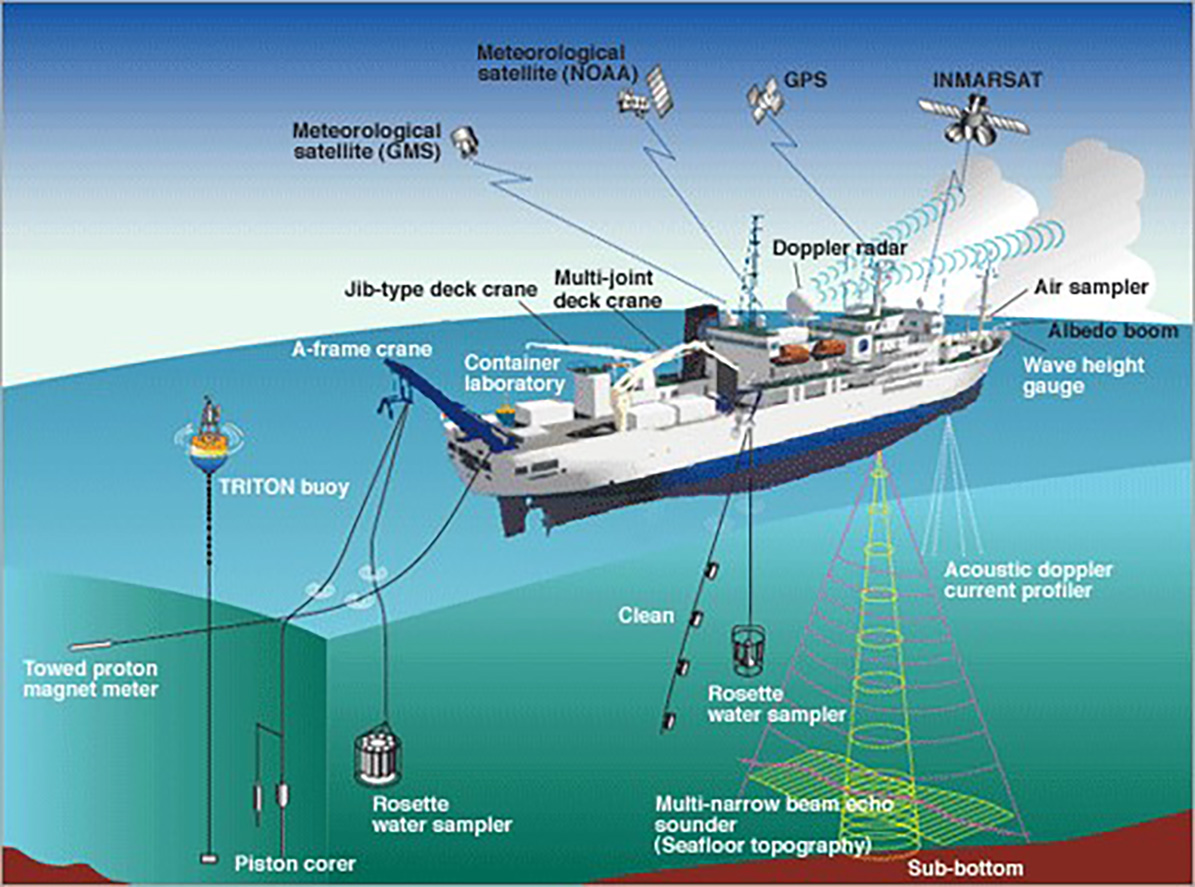
Important points to JAMSTEC and to Japan's Arctic Ocean research was that R/V Mirai was built as an ice-capable research vessel. The ice class of R/V Mirai is NK-1A corresponding to PC7, which is capable of navigating in summer and autumn breaking through thin first-year ice with some mixed multi-year ice. This made it possible to conduct observation cruises even in the Arctic Ocean with our own research vessel and our own plans.
Prior to the start of observations in the Arctic Ocean by R/V Mirai, an international workshop was held in Yokohama in February 1998. The workshop was attended by 45 researchers from Japan, the U.S., Canada, Russia, and Germany. Over three days, 31 presentations were made on the latest projects and research results related to the Arctic Ocean research, including shelf-basin interaction, which was one of the hottest topics at the time, and the linkage among observations, theory, and modeling. Discussions and communication among the participants of this workshop greatly advanced our subsequent research activities. For example, based on this workshop and the subsequent exchange of ideas, we were able to join the cruise in the Beaufort Sea of the Arctic Ocean by the Canadian Coast Guard Ship (CCGS) Sir W. Laurier in the summer of 1998 and 1999 to deploy and recover mooring systems off Alaska. JAMSTEC’s participation in this cruise was the first step in an ongoing collaboration between the Department of Fisheries and Oceans (DFO), Canada, and JAMSTEC.
The first cruise to the Arctic Ocean by R/V Mirai took place in August 1998. The departure from Japan at Hachinohe port was on July 31. Conducting trial observation on the coast of Hokkaido Island and in the western north Pacific, R/V Mirai is moving eastward and arrived at Seward, Alaska on August 12. Seward is a small town facing the Pacific Ocean and the home port of the Alpha Helix of the University of Alaska, USA, to which we were indebted, is located, as shown in chapter II. We had the Open House event at Seward (see Side note below), and leave for the Arctic Ocean on August 14.
Our target area for this cruise was the area off the Barrow (now called Utqiaġvik), Alaska, which is the northernmost town in the US. In this area, about 55% of the water flowing through the Bering Strait passes through and enters the basin area of the Arctic Ocean. Also, when northeasterly winds become stronger, upwelling of warm water from the lower layer occurs, which is originating from the Atlantic Ocean. It is a key area between the continental shelf and the deep basin and for marine physics, chemistry, biology, and human life. We conducted 22 CTD/water-sampling observations, collected samples with plankton nets, and took a boat out on the sea ice to collect sea ice samples. Although there was still sea ice on the west side of the Barrow canyon in mid-August 1998, we successfully conducted observations while avoiding sea ice, and confirmed that we were able to collect samples of sea ice and other materials. Figures 3 and 4 show a map of observation sites with the location of the ice edge and pictures taken during the cruise. It was a fruitful experience.
Sea ice condition in the summer of 1998 was slightly tough and different from other years. On the way back at the Bering Strait on August 28, 1998, we encountered sea ice flowing from the Siberian side. Careful navigation was required. For more details, Capt. M. Akamine, who is the first Captain of R/V Mirai Arctic cruises, wrote an article about the operation of R/V Mirai Arctic Cruise between 1998 and 2008 in the JOS Newsletter 2022 No.2 (written in Japanese). Please take a look at it (vii).
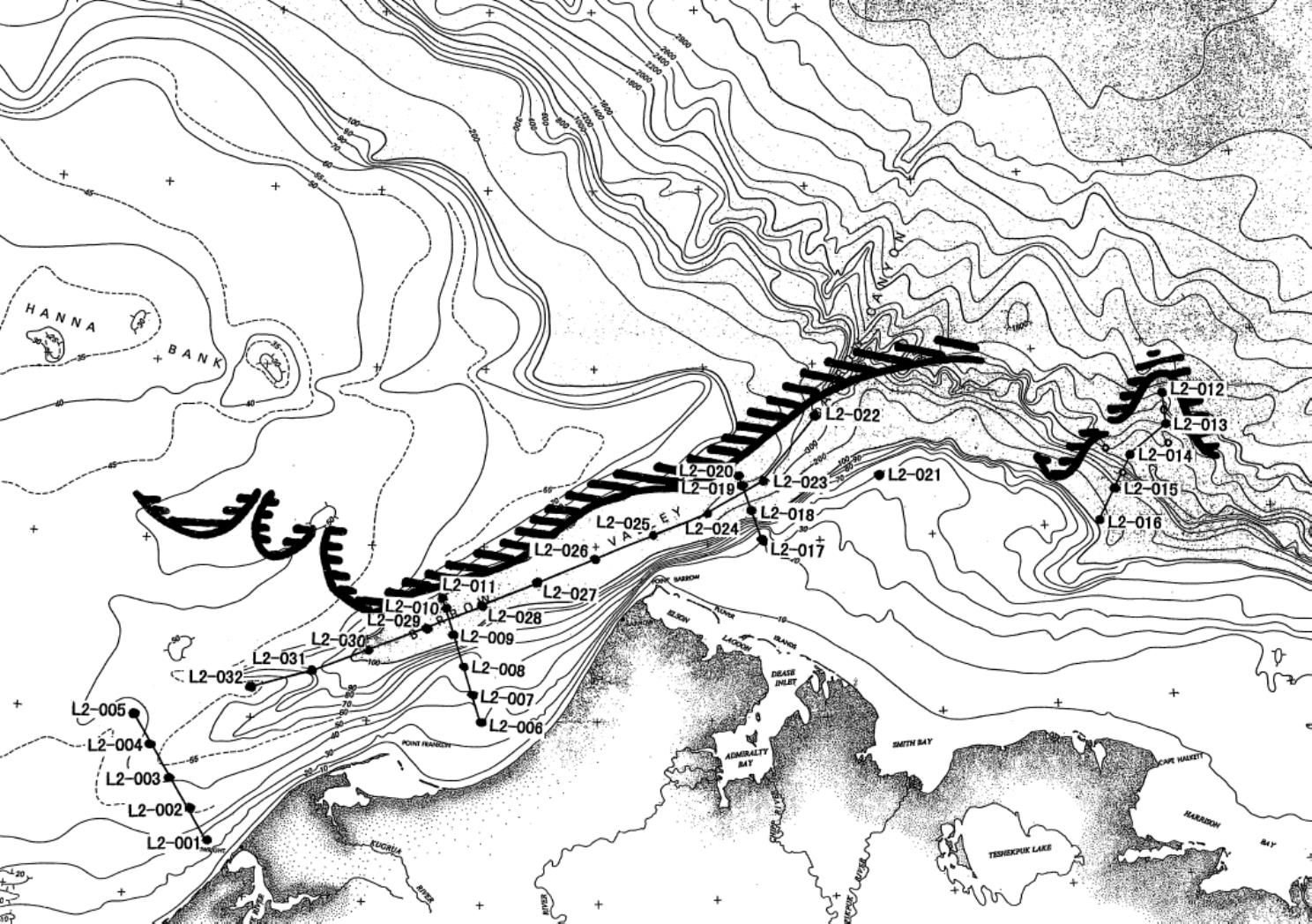
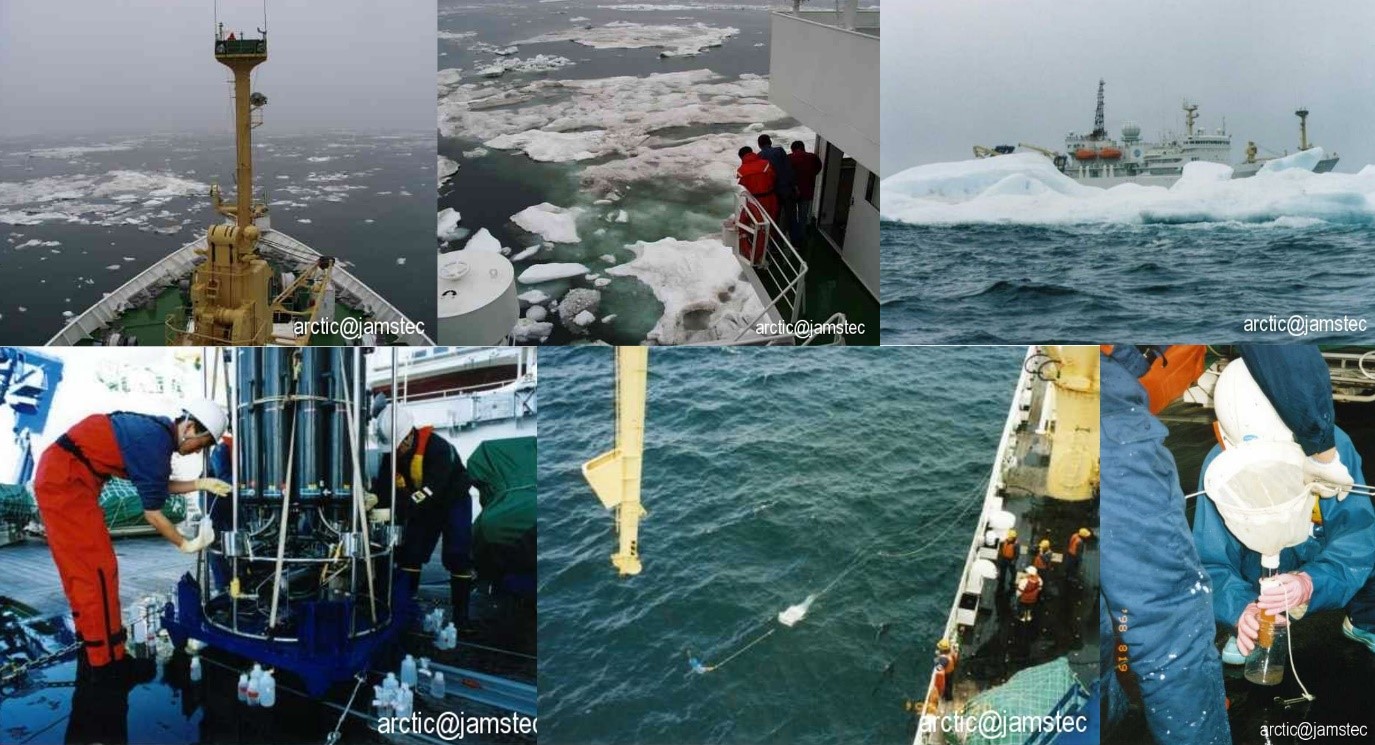
In 1999 and 2000, we conducted R/V Mirai Arctic cruise in September, when sea ice was at its minimum extent. The main observation area was around the shelf-slope area between the Chukchi Sea, a continental shelf extending north of the Bering Strait, and the Beaufort Sea, a deep basin. We confirmed that a variety of observations, such as CTD/water sampling, meteorological observations, plankton sampling using different types of the net, sea ice sampling using boats, and bottom-sediment sampling using corers, could be made in this area.
Based on the above experiences and exchanges, an MOU (Memorandum of Understanding) was signed between the Department of Fisheries and Oceans (DFO) of Canada and JAMSTEC in 2002. Under this MOU, the Institute of Ocean Sciences of Canada (IOS) and JAMSTEC initiated a collaborative research project, named JWACS (Joint Western Arctic Ocean Climate Studies). IOS used the Canadian Coast Guard icebreaker Louis S. St. Laurent (Figure 6) to observe the eastern to central Canadian Basin, while JAMSTEC operated R/V Mirai to observe from the Chukchi Sea to the western Canadian Basin, for sharing data and conducting joint analysis to understand the status and changes in the Pacific sector of the Arctic Ocean. In particular, on the 2002 mission, many researchers first were onboard CCGS Louis S. St. Laurent together with Canadian scientists, then Japanese scientists moved by boat off Barrow to R/V Mirai and CCGS S. W. Laurier (Figure 6), for continued observation and operations. During the cruise, R/V Mirai headed eastward along the coast of Alaska and Canada, and also conducted observations in the waters of the Canadian EEZ in addition to the US EEZ area (Figure 7). Just at this time when sea ice reduction in the Arctic Ocean was becoming a hot topic, the distribution of water masses entering the Arctic Ocean from the Pacific Ocean and its impact on sea ice reduction had been investigated further.
In 2003, the Woods Hole Oceanographic Institution (WHOI) started an international collaboration project, Beaufort Gyre Exploration Project (viii), with the IOS about the CCGS L. S. S. Laurent cruise, and Canada-US-Japan cooperative observation research system was established. R/V Mirai continued observation cruises in the Pacific sector of the Arctic Ocean in 2004, 2006, 2008, 2009, and 2010. During this period, the area where R/V Mirai was able to observe expanded as the sea ice retreated. In particular, R/V Mirai Arctic cruises in 2008, 2009, and 2010 reached around 79 degrees north latitude, respectively (Figure 8). The Canada-Japan joint research project has been renewed from JWACS to PACI (Pan-Arctic Climate Investigation) in 2009 and has become a joint research program in a broader field that includes not only physics but also biogeosciences. This international cooperative observation covering the Pacific sector of the Arctic Ocean is still ongoing and has produced many research results showing rapid environmental changes associated with sea ice reduction.
In the next article, we would like to describe the highlights of the scientific results, that use the data above and were presented during the period of III.
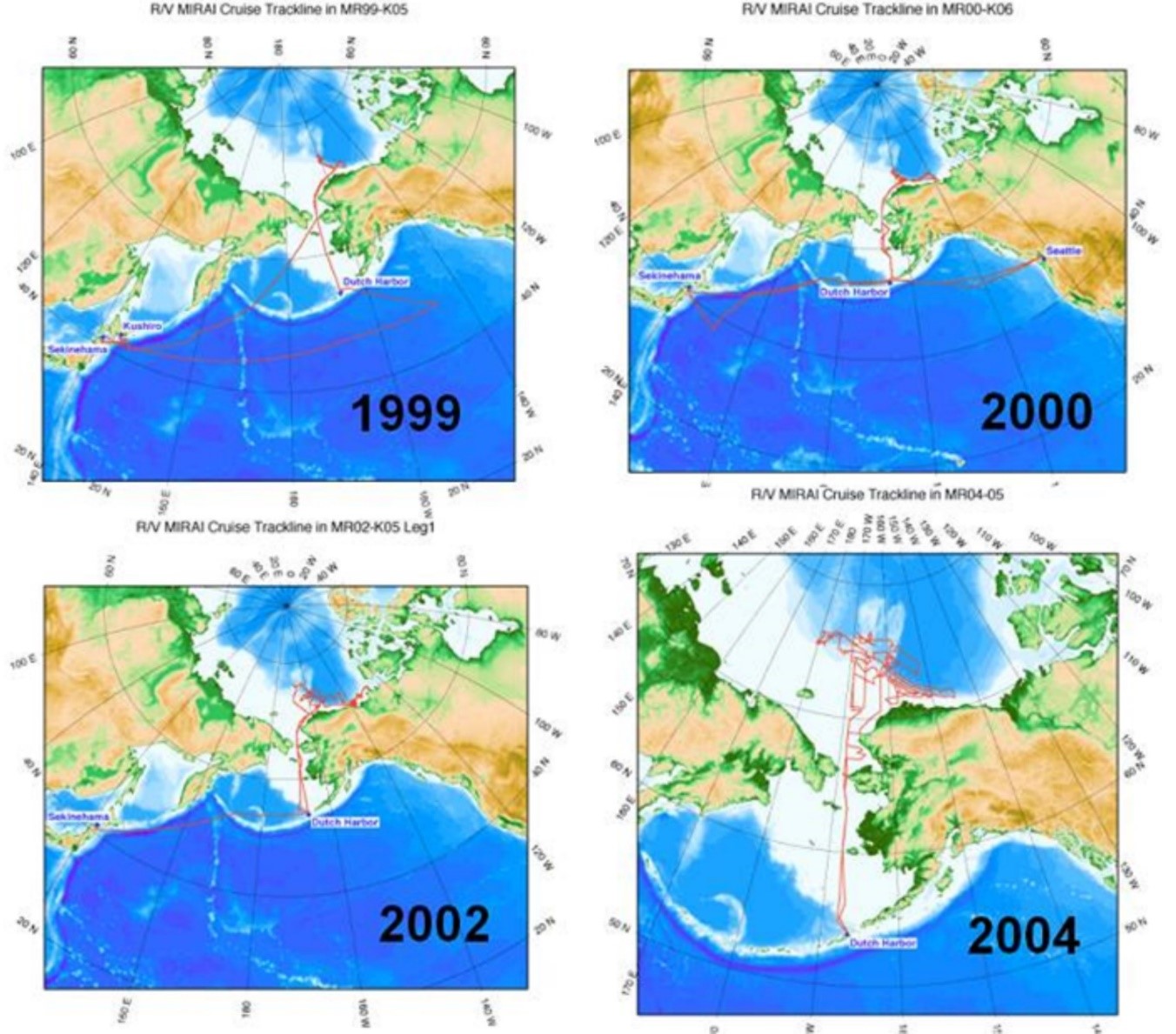
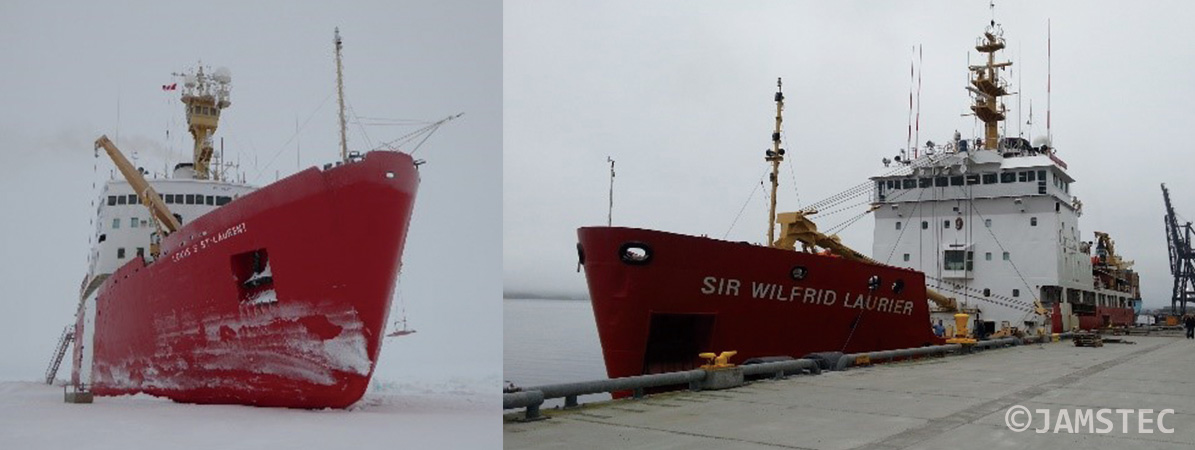
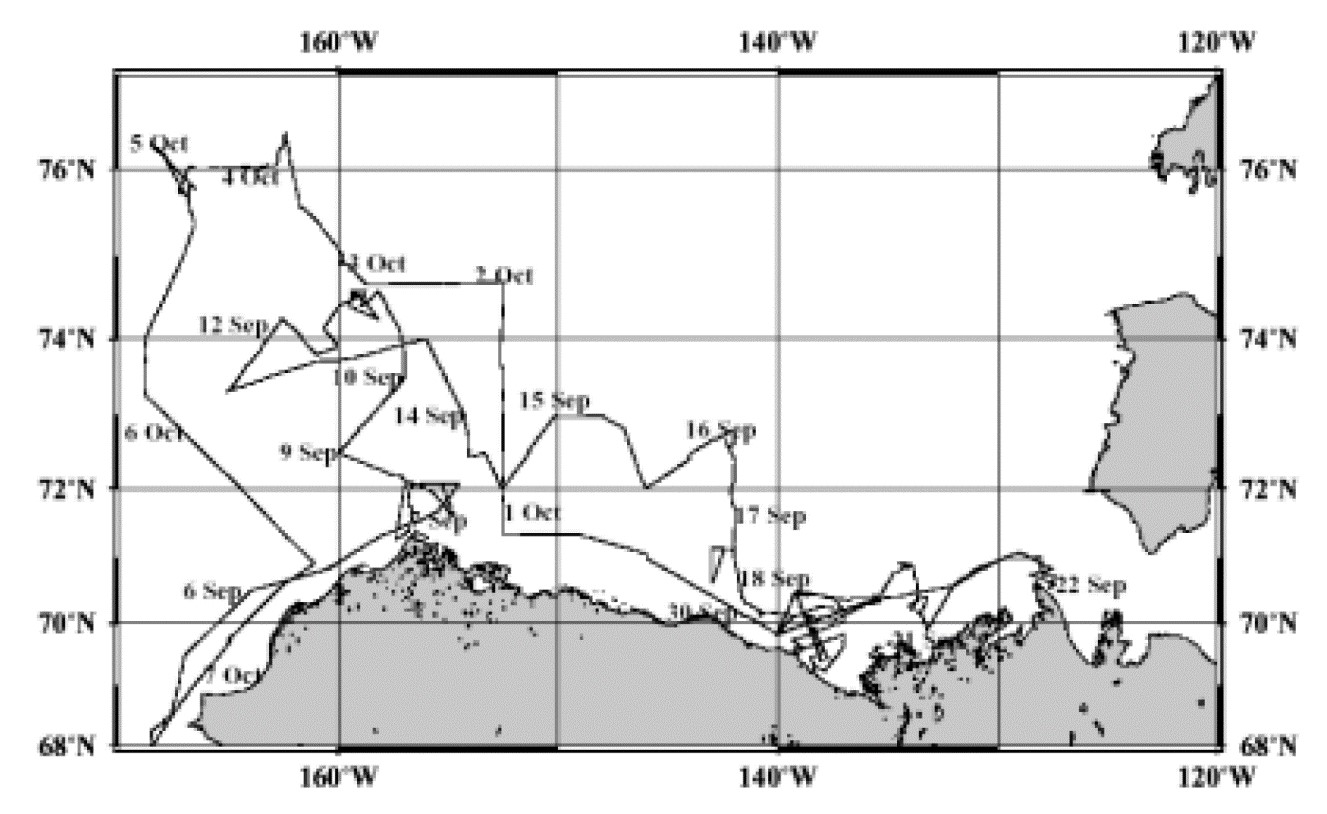
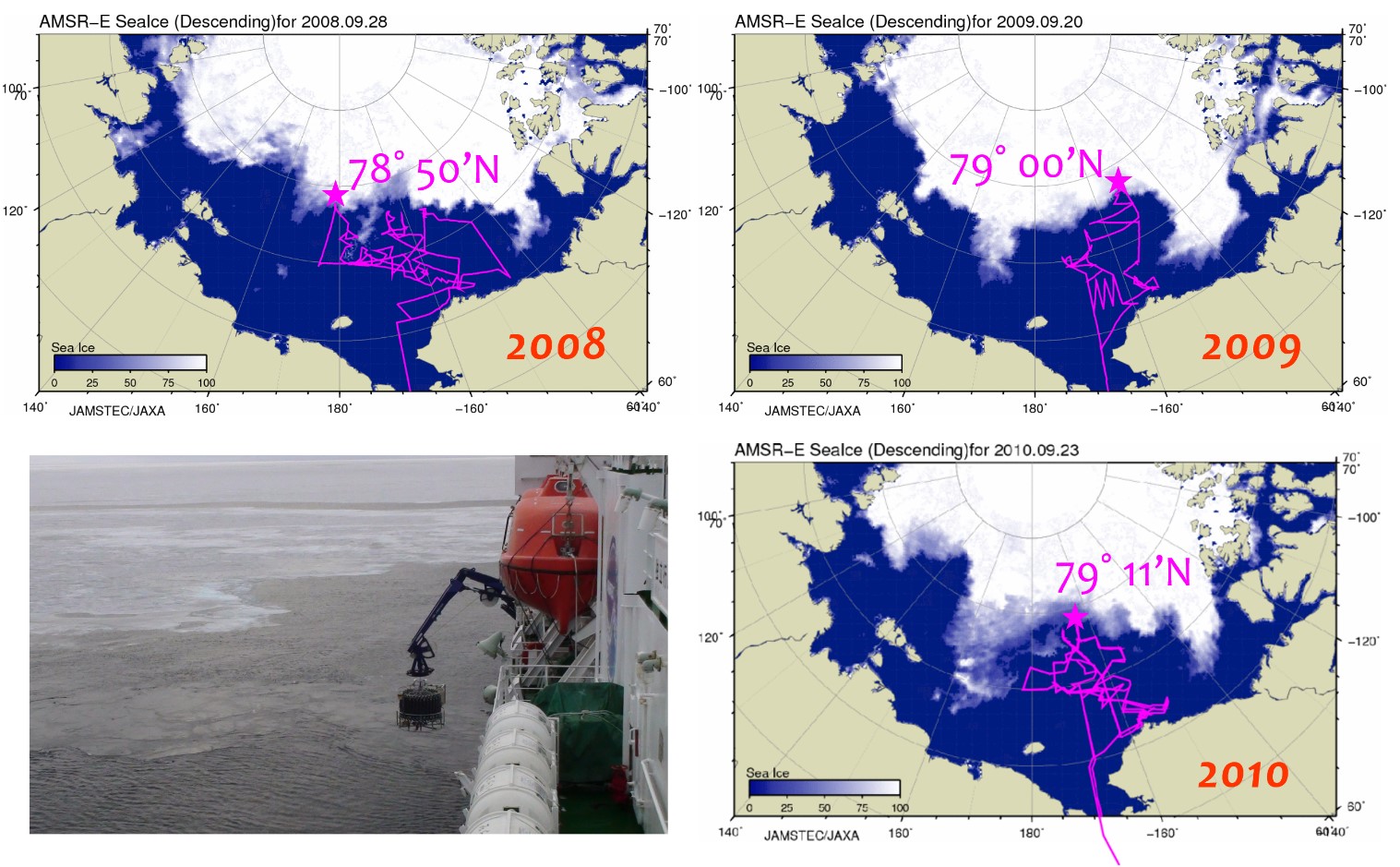
Side Note: Open House events of R/V Mirai in foreign countries
During the first some years, we often held “Open House” events of R/V Mirai at ports in Japan and abroad when we stopped on our voyages. As for the R/V Mirai Arctic cruise, on our first Arctic cruise in August 1998, we held an open house event in the Alaskan small town of Seward (Figures 10 and 11), the home port of the Alpha Helix of the University of Alaska, USA, to which we were indebted, is located, as shown in chapter II. Seward is a town facing the Pacific Ocean about a three or four-hour drive south of Anchorage. It is the starting point of the Alaska Railroad on the Pacific Ocean side and a famous port for cruise ships coming for sightseeing in the fjords. It is a small town with a population of about 3,000. In that town, R/V Mirai held an open house event! If my memory is correct..., despite the small size of the town, about 650 people visited the event, and I remember being surprised at the level of interest shown by everyone.
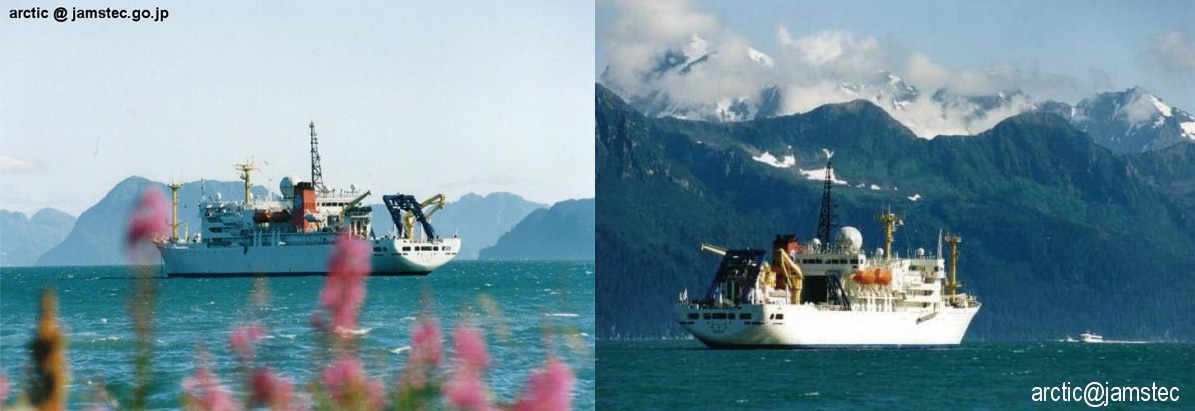
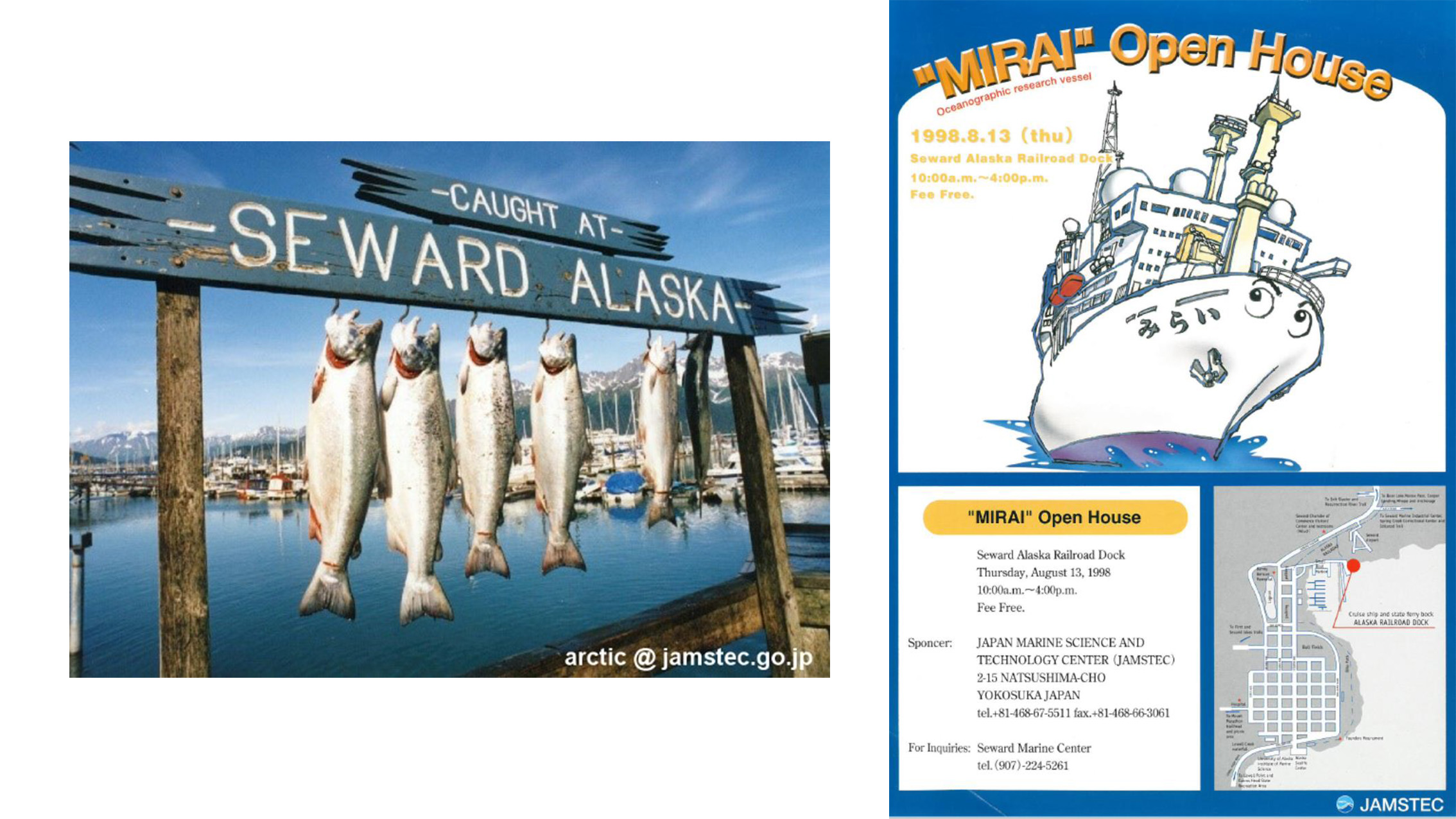
During this open house in Seward, visitors were able to see inside R/V Mirai and several panels displayed on the ship. Also, handouts were distributed. Figure 12 is an introduction paper (handout) on the Arctic research distributed at this event. As a background of global environmental research at that time, it was important to note that the IPCC Second Assessment Report was released in 1995, which indicated that global warming was progressing due to the effects of human activities, and prevention of global warming began to become a hot topic of discussion. Then, the third session of the Conference of the Parties to the UN Framework Convention on Climate Change (COP-3) was held in Kyoto, Japan, in December 1997, and the Kyoto Protocol was adopted, mandating the regulation of greenhouse gas emissions. In the Arctic, there was also a growing concern about the environmental changes that will occur as a result of global warming. For instance, sea ice in the Arctic Ocean was shrinking. The permafrost, glaciers, and ice sheets were also melting. The effects of these changes would affect the entire global environment, including plants, animals, sea level rise, and so on. It was around this time that the ideas that would form the basis of the research activities currently underway began to emerge. Interestingly, the handout includes references to the effects of global warming as described above, in addition to the differences between the Arctic and Antarctic regions.
We followed this up in 2000 with open house events of R/V Mirai in Seattle, Washington, USA, and Victoria, British Columbia, Canada, before moving to the Arctic Ocean cruise. In Seattle, many friends of the University of Washington and NOAA, with whom we had worked together on the NPEO (see III-1), visited this event and enjoyed the atmosphere of R/V Mirai and communication with Japanese scientists and sailors. Also, many Canadian scientists working at the Institute of Ocean Sciences of Fisheries and Oceans Canada came to see R/V "Mirai open house event in Victoria. It was an enjoyable exchange, and we were able to demonstrate our presence, which greatly contributed to the development of subsequent collaborative research.
Of course, we had open house events and receptions not only during the Arctic cruises but in other Mirai cruises. For example, the Blue EArth GLobal Expedition (BEAGLE) cruise was conducted by R/V Mirai from 2003 to 2004, which main purpose is the high-quality observation along the Antarctic circumpolar WOCE (World Ocean Circulation Experiment) lines to detect the decadal change of ocean conditions. During the cruise, open house events, receptions and exchanges were held in Brisbane on the east coast of Australia, Valparaiso in Chile, Santos in Brazil, Cape Town in South Africa, Tamatave in Madagascar, and Fremantle on the west coast of Australia (x). Such events demonstrated to the public and to the world that the R/V Mirai would be working internationally for global ocean research.
Personally, I would like to conduct a trans-Arctic cruise from the Pacific side to the Atlantic, when Japan’s new research icebreaker is available for the Arctic Ocean observation. For example, JAMSTEC is now doing international collaboration research with the Norwegian Polar Institute and the University of Tromsø which are located in Tromsø, a city in northern Scandinavia facing the Atlantic Ocean, and the Alfred Wegener Institute located in Bremerhaven, Germany, which has the biggest port in Germany. I can imagine that it would be possible to visit these places and have open house events there. It would be nice to be able to talk about our research collaboration with many friends in Norway, Germany, and other European countries while seeing our new research icebreaker docked alongside the Norwegian icebreaker FF Kronprins Haakon or the German icebreaker FS Polarstern. The last paragraph was a story of my own imagination (^^!
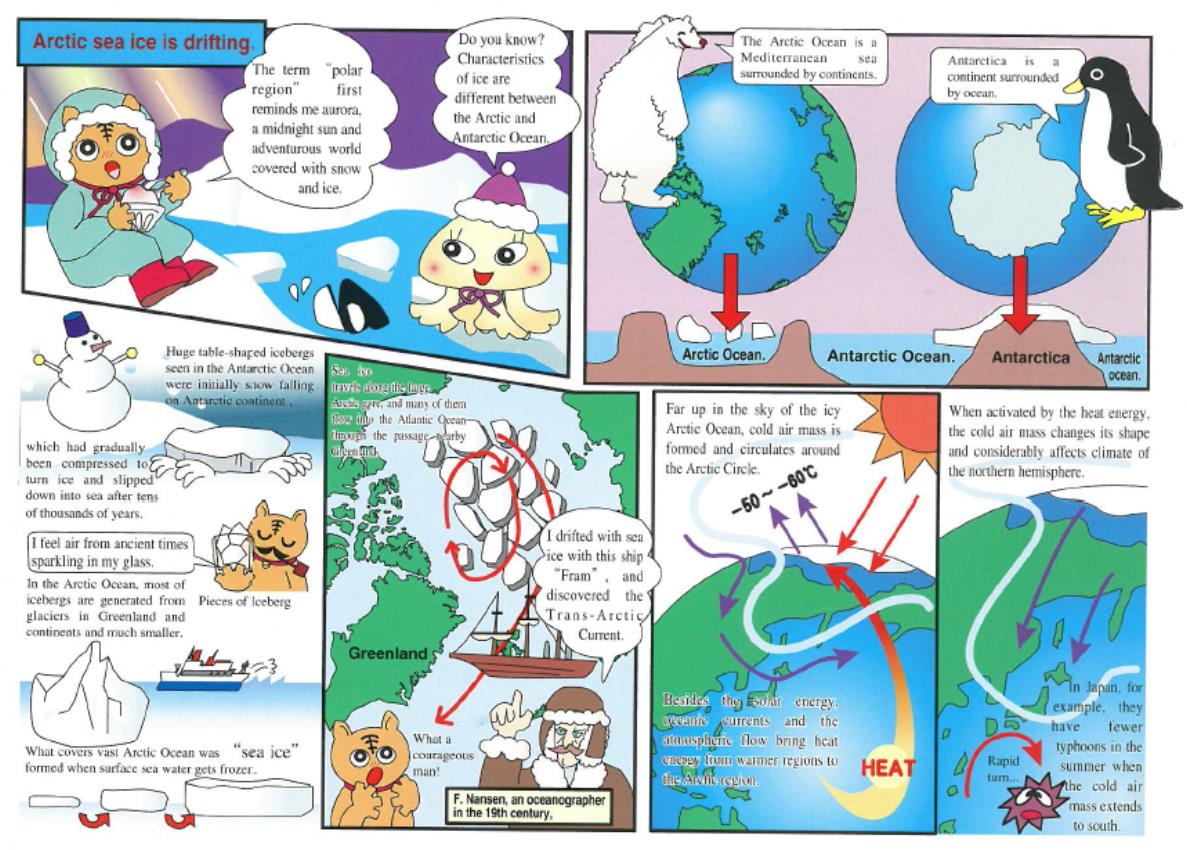
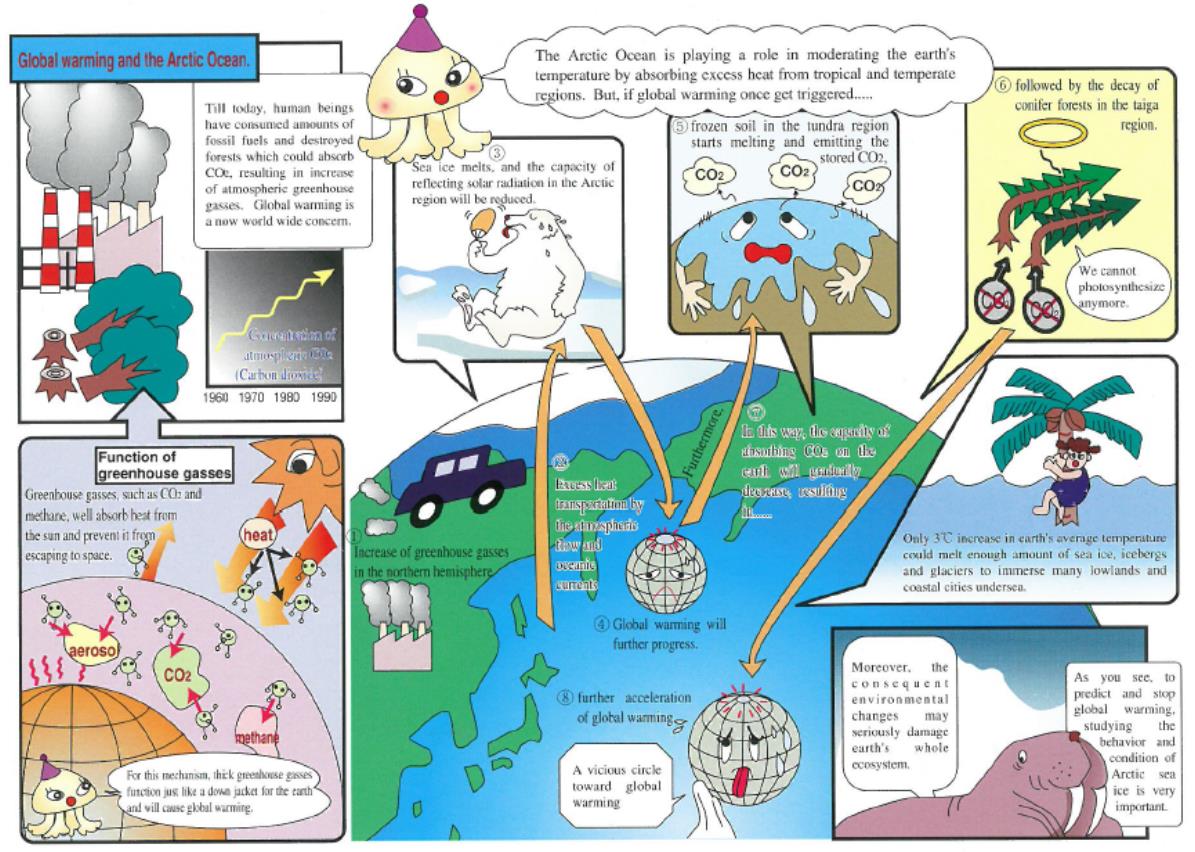
References
- Takizawa, T. (2001). Observational Research in the Arctic Ocean. The 30th Anniversary of the Japan Marine Science and Technology Center, Chapter 2. As a comprehensive marine research institute, p.102-108. (In Japanese)
- Kikuchi, T. (2022). History and Future of Arctic Ocean Research-Toward New Japanese Research icebreaker for the Arctic Ocean-. KANRIN/Bulletin of The Japan Society of Naval Architects and Ocean Engineers, 101, 28-34. (In Japanese)
- JAMSTEC Homepage (About JAMSTEC > Research Vessels, Facilities and Equipment > Research Vessels and Vehicles > MIRAI), https://www.jamstec.go.jp/e/about/equipment/ships/mirai.html ,(Ref.:2023-1-17)
- Itoh et al. (2013). Barrow Canyon volume, heat, and freshwater fluxes revealed by long-term mooring observations between 2000 and 2008. J. Geophys. Res. -OCEANS, 118, 4363–4379, doi:10.1002/jgrc.20290.
- Aagaard, K., and A. T. Roach (1990), Arctic ocean-shelf exchange: Measurements in Barrow Canyon, J. Geophys. Res., 95(C10), 18,163-18,175, doi:10.1029/JC095iC10p18163.
- Hirano, D., Y. Fukamachi, E. Watanabe, K. I. Ohshima, K. Iwamoto, A. R. Mahoney, H. Eicken, D. Simizu, and T. Tamura (2016), A wind-driven, hybrid latent and sensible heat coastal polynya off Barrow, Alaska, J. Geophys. Res. Oceans, 121, doi:10.1002/2015JC011318.
- Masaharu Akami e (2022). Looking back of R/V Mirai cruise(No.1. Changing the Arctic Ocean, Operation of R/V Mirai), JOS News Letter (https://kaiyo-gakkai.jp/jos/publications/newsletter ), Vol.12, No.2, p.6-10. (written in Japanese)
- Beaufort Gyre Exploration Project (Wood Hole Oceanographic Institution) Home page, https://www2.whoi.edu/site/beaufortgyre/ (ref.:2023-1-23).
- JAMSTEC Press “On the open house event of R/V Mirai in Seward, Alaska, US (August 7, 1998)”, https://www.jamstec.go.jp/j/about/press_release/1998/19980807/ (ref.:2023-1-23) (written in Japanese)
- JAMSTEC Homepage “R/V Mirai, the Blue EArth GLobal Expedition (BEAGLE) cruise 2003」, https://www.jamstec.go.jp/beagle2003/jp/ (ref.:2023-1-23) (written in Japanese)

